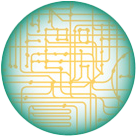Developing Temperature-Jump X-Ray Crystallography to Study Dynamic Biosynthetic Enzymes at Synchrotrons and X-Ray Free-Electron Lasers
Authors:
Michael Thompson1* ([email protected]), Alexander Wolff1, Aaron Brewster2, Sergio Carbajo3,4, Alec Follmer5, Judith Klinman6, Adam Offenbacher7, Daniel Paley2, Frederic Poitevin3, Nicholas Sauter2, Ray Sierra3, Mark Wilson8, Iris Young2, Mark Hunter3, Aina Cohen3
Institutions:
1University of California–Merced; 2Lawrence Berkeley National Lab; 3SLAC National Accelerator Laboratory; 4University of California–Los Angeles; 5University of California–Irvine; 6University of California–Berkeley; 7East Carolina University; 8University of Nebraska–Lincoln
Goals
The overall goal of this project is to develop robust and accessible tools for measuring macromolecular dynamics at DOE X-ray lightsources. As a proof of concept, researchers are studying the catalytic mechanism of lipoxygenase enzymes, which operate via a rate-limiting hydrogen tunneling.
Abstract
Conformational dynamics underlie many important biochemical functions, such as enzyme catalysis, but they remain difficult to study. Rising to this challenge, the current generation of X- ray lightsources, including DOE synchrotrons and X-ray free electron lasers (XFELs), offers new opportunities to study molecular motion using time-resolved crystallography. These instruments produce ultrafast, high-brilliance X-ray pulses that enable the observation of protein dynamics in real time following a rapid perturbation that synchronizes motion within the ensemble of crystallized molecules. To help make time-resolved crystallography a general tool that can be applied to study the dynamics of any protein of interest, the group is developing the use of infrared laser-induced temperature-jump (T-jump) as a rapid perturbation. This poster will describe the team’s collaborative effort to pilot the use of new hardware and software for T-jump X-ray crystallography across structural biology facilities at SLAC National Laboratory. Development of T-jump crystallography methods synergize with the project’s mechanistic studies of lipoxygenase enzymes, which catalyze carbon hydrogen (C-H) bond activation reactions. The rate-limiting step for lipoxygenase catalysis is the abstraction of hydrogen via a tunneling mechanism, which is hypothesized to be linked to conformational dynamics that modulate the donor-acceptor distance. Researchers are using T-jump crystallography to test this hypothesis by mapping the conformational dynamics of several lipoxygenase variants with different catalytic properties. This comparative analysis will lend insight into which of the observed motions are functional in catalysis, and which are not. Experiments performed at both synchrotron (SSRL) and XFEL (LCLS) facilities will allow scientists to access broad timescales ranging from nanoseconds to milliseconds. Lipoxygenases are model systems for enzymatic C-H bond activation and prototypes for studying the role of tunneling in enzymatic reactions. This research will help shed light on the mechanistic details of how conformational dynamics promote function in these enzymes.
References
This research was supported by the DOE Office of Science, BER program, grant no. DE-SC0012345. Use of the Stanford Synchrotron Radiation Lightsource (SSRL), SLAC National Accelerator Laboratory, is supported by the U.S. DOE, Office of Science, Basic Energy. Sciences program under Contract No. DE-AC02-76SF00515. The SSRL Structural Molecular Biology Program is supported by the DOE BER program, and by the National Institutes of Health (NIH), National Institute of General Medical Sciences (NIGMS) (including P41GM103393). Use of the Linac Coherent Light Source (LCLS), SLAC National Accelerator Laboratory, is supported by the U.S. DOE, Office of Science, Basic Energy Sciences program under Contract No. DE-AC02-76SF00515. The SSRL Structural Molecular Biology Program is supported by the DOE BER program, and by NIH, NIGMS (including P41GM103393). The contents of this publication are solely the responsibility of the authors and do not necessarily represent the official views of NIGMS or NIH.
